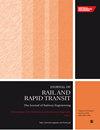The influence of semi-actively controlled magnetorheological bogie yaw dampers on the guiding behaviour of a railway vehicle in an S-curve: Simulation and on-track test
IF 2.1
4区 工程技术
Q3 ENGINEERING, CIVIL
Proceedings of the Institution of Mechanical Engineers Part F-Journal of Rail and Rapid Transit
Pub Date : 2024-09-14
DOI:10.1177/09544097241282728
引用次数: 0
Abstract
Many publications have shown that semi-actively controlled dampers could significantly improve the behaviour of a road or rail vehicle. In the case of a railway vehicle, these dampers promise to solve the contradiction between the damping requirements of different running modes (fast running on a straight track vs negotiating a tight curve). It is known that semi-active control of a bogie yaw damper can improve the vehicle behaviour when running fast on a straight track, but it is not known whether such semi-active control worsens the vehicle behaviour when negotiating a tight curve. This paper investigates the application of magnetorheological bogie yaw dampers in the locomotive bogie to reduce guiding forces and wear in wheel-rail contact when the vehicle negotiates the S-curve. The paper describes the magnetorheological damper, its mathematical model and the strategies for its semi-active control, followed by the results of simulations on a complex multi-body locomotive model and on-track testing on a real vehicle. The simulations and on-track tests have shown that the use of semi-active control of the yaw dampers reduces the guiding force by about 10%. The reduction in these forces will lead to a reduction in wear in the wheel-rail contact.半主动控制磁流变转向架偏航阻尼器对铁路车辆在 S 型弯道中的导向行为的影响:模拟和轨道测试
许多出版物表明,半主动控制阻尼器可以显著改善公路或铁路车辆的性能。就铁路车辆而言,这些阻尼器有望解决不同运行模式对阻尼要求之间的矛盾(在平直轨道上快速行驶与在狭窄弯道上转弯)。众所周知,转向架偏航阻尼器的半主动控制可以改善车辆在直线轨道上快速行驶时的性能,但这种半主动控制是否会恶化车辆在急转弯时的性能却不得而知。本文研究了在机车转向架中应用磁流变转向架偏航阻尼器,以减少车辆通过 S 形弯道时的导向力和轮轨接触磨损。论文介绍了磁流变阻尼器、其数学模型和半主动控制策略,随后介绍了复杂多体机车模型模拟和实车轨道测试的结果。模拟和轨道测试表明,使用半主动控制偏航阻尼器可将导向力降低约 10%。这些力的减少将导致轮轨接触磨损的减少。
本文章由计算机程序翻译,如有差异,请以英文原文为准。
求助全文
约1分钟内获得全文
求助全文
来源期刊

CiteScore
4.80
自引率
10.00%
发文量
91
审稿时长
7 months
期刊介绍:
The Journal of Rail and Rapid Transit is devoted to engineering in its widest interpretation applicable to rail and rapid transit. The Journal aims to promote sharing of technical knowledge, ideas and experience between engineers and researchers working in the railway field.
 求助内容:
求助内容: 应助结果提醒方式:
应助结果提醒方式:


